Most of the world knows about the Russian “Bloody Sunday” of 1905, but few other than Orthodox Christians know that Tsar Nicholas II and his entire family are saints, canonized by the Russian Church. As time distances us from the events leading up to the Bolshevik revolution, it becomes clearer how various world forces were working together inside and outside of Russia to bring down the monarchy, destabilize the country, and institute a new order that was less supportive of a Russian national identity, and more congenial to an international schedule of intentions. That the Japanese helped finance a Paris conference aimed at destabilizing Russia during the Japanese war, that the Germans sponsored Lenin and returned him to Russia just as she was about to win World War I, and that American tycoons helped finance anarchist terrorists at a time when pogroms were occurring in the south of Russia and the Ukraine, all become more obvious as factors enabling the truly bloody revolution in Russia, and the overthrow of the lawful monarch. One can say, c’est la guerre, but let it not sully the name of Tsar Nicholas II and his family, the holy Royal Martyrs and Passion Bearers, who were targets of these forces simply because they were the sovereigns of a powerful Orthodox nation. An article from the Moscow periodical, Tatianin Den (St. Tatiana day) discusses what happened on that day.
* * *
 |
| January 9, 1905. A group of demonstrators blocked by the guard. |
Even some of those who know that the Tsar was not in St. Petersburg at the time insist that he consciously "hid himself from the people", and was "bound by duty to come and receive the petition" that the crowd had brought for his attention. For many, even for some Orthodox Christians, the idea of that fateful day of January 9, 1905 is utterly incompatible with the idea of the Tsar's sainthood.
Was the Tsar responsible?
In the "Material connected with the question of the canonization of the Royal Family" (published by the Synodal committee for the canonization of saints in 1996, hereafter called the "Material"), a separate, thorough article was dedicated to the tragedy of January 9, in the conclusion of which is stated: "The Tsar bore the burden of moral responsibility before God for all the events that occurred in the state entrusted to him." Thus, a share of responsibility for the tragic events of January 9, 1905 lies on the Emperor. The Tsar, as we shall see, did not deny this responsibility. It is worth noting that the "Material" was released as a separate book, entitled, He Forgave Everyone… Emperor Nicholas II. The Church on the Royal Family (St. Petersburg, 2002).
"Just the same," the Material states, "this share of responsibility cannot at all be compared with the moral and historical guilt for the willful or involuntarily preparation or failure to prevent the tragedy of January 9, which lies on such historical players as, for example, the defrocked priest, George Gapon, or the dismissed Minister of Interior Affairs, Peter Dimitrievich Sviatopolk-Mirsky." That the latter was assigned to this position, or that he was not removed from it in time, could hold Nicholas II liable for reproach. If only such reproach were not the ad nauseum of knowing better what the Tsar should have done.
The Minister "of trust".
In mid July of 1904, the Minister of Interior Affairs, Vyacheslav Konstantinovich von Plehve, was killed by a bomb thrown into his carriage. The Tsar did not decide immediately upon his replacement. The appointment came only in August, 1904. This was apparently a maneuver by the Tsar, because unlike the conservative Plehve, Sviatapolk Mirsky was famous for his liberal tendencies. In autumn of 1904, liberalism entered Russian history as "the spring of Sviatopolk-Mirsky", who openly proclaimed the need for trusting relations between the government and society. This was a time of social unrest in Russia. Throughout "society" under various pretexts, talk of the need for change and the need for a constitution could be heard. A meeting of the elective district council (zemstvo) took place in Petersburg, which had not received permission from Nicholas II to open, but having received implicit permission from Sviatopolk-Mirsky, who let the delegates know that he would look the other way during its duration. The meeting unanimously accepted a liberal declaration and presented it to "their" Minister, to the latter's great chagrin. The Tsar was outraged, but did not accept the Minister's resignation.
When it had already become known that a demonstration of unprecedented scope was in the making, the Minister of Interior Affairs reassured himself and others with the words that it would be enough to explain to the people that the Tsar was not in the capital, and they would peacefully disperse… Help from the army, he supposed, would only be needed to prevent a crush in the center of town. On the evening of January 8, 1905, Sviatopolk-Mirsky came to Tsarskoe Selo and reported on the situation in the capital to the Tsar. He assured him that despite the enormous number of striking workers, the situation does not merit serious caution; he did not say a single word about the upcoming march of workers to the Winter Palace, the calling of army battalions to the capital, and the plans to oppose the demonstration using the armed forces. When he had returned to St. Petersburg late that evening, he conducted a governmental meeting about the plans for the following day…
A suitable personage.
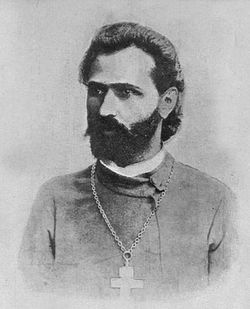
|
| George Gapon |
The name of George Gapon has long been united with the tag, "provocateur", and he as an individual has never been deemed worthy of attention. In the "Material", as well as in the book, George Gapon: Truth and Fiction, by I. Ksenofontov (Moscow 1997), and in the more recent book by M. Pazin, Bloody Sunday. Behind the Scenes of the Tragedy, (Moscow 2009), Priest George Gapon is presented as an outstanding and gifted man. From his early years he felt compassion for working people, and thought about how to help them in deed. His intentions were sincere, and his compassion was unfeigned; otherwise, he would not have been so able to win people's hearts, as he doubtlessly did. But unfortunately, his better feelings were mingled with ambition and excessive status seeking. Possessing in addition a gift for theatrics, he was able to win the trust of the most common people as well as the highly placed. The modern Orthodox historian, Fr. Vasily Sekachev, takes a merciful and thoughtful view of this man in the periodical Neskuchny Sad dedicated to the 100-year anniversary of "Bloody Sunday," in an article entitled, "The Tragedy of Priest Gapon". Truly, "Woe to him through whom temptations come." George Gapon was a just too suitable a figure for the provocateur of the human race, the devil, whose "special mission" he fulfilled quite diligently.
Gapon's main "baby" was the "Union of Russian factory workers of St. Petersburg", a legal organization created in order to encourage mutual aid between workers, and to conduct various cultural-enlightenment events for them. The historian S. Oldenburg was not entirely fair when he placed Gapon entirely on the side of the revolution. Gapon did not really know what he wanted, he was loyal neither to the government, nor to the revolutionaries who had infiltrated his circles (which is why the socialist revolutionary Esser party murdered him in 1906), he simply wanted to be seen, and therefore unavoidably veered to the "left". A certain "secret five", who led the Union, was made up of opposition-minded people, connected also with the Social Democrats, and possibly with the Essers. The police's inaction was outrageous; but this was also a result of Gapon's theatrics—the authorities trusted him entirely.
The idea of marching to the Tsar.
Nevertheless, the march of January 9 can hardly be considered a provocation calculatingly prepared by revolutionaries. There was both preparation and spontaneity. It is another matter that in September, 1904 in Paris, there had already been a conference (funded by Japanese money! This was during the Russo-Japanese War) of powers oppositional to the Russian Empire, one of whose resolutions was to use every crisis to further the creation of a revolutionary situation. However, such a gift as it was to the Leftist powers—"a shooting by the Tsar at a peaceful demonstration"—became possible largely thanks to the enthusiastic activity of George Gapon. The concentration of attention upon the Tsar, an arousal of general hope in the Tsar, who was "fenced off by bureaucrats" from the people, an address to the Tsar personally—all this was the creative demagogy of Gapon. As a result, the simple-hearted people went "to see the Tsar", dressed in clean clothes, with their children… None of the activists of the revolutionary movement loved the Tsar (naturally), and even less did they pay any attention to the love that common people had for him. Gapon did not know the people he had turned to.
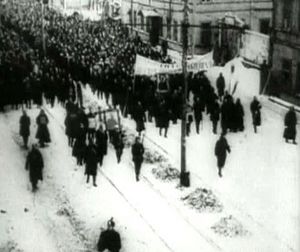 |
| One of the columns marching. |
On December 21, Port Arthur fell. At the end of December, a reason for a large strike arose: at the Putilov Factory, four workers, members of the Union, were supposedly fired. In fact, there was only one (!) worker fired, but one lie led to another, the agitation grew, and demands about their comrades at work became "economic demands", amongst which were some total impossibilities, like an eight-hour day (unthinkable during wartime at a factory that filled orders from the military) or free medical services not only for the workers, but also for their family members. The strike escalated, at times spontaneously, at times not at all spontaneously. The activists of the striking facility appeared at the working facility and forced the workers (for example, by threats of beatings) to drop their work. How this took place is described in detail in the above mentioned book by M. Pazin, and in a book by P. Multatuli, The Lord has Visited Us Harshly by His Wrath… Emperor Nicholas II and the Revolution of 1905–1907 (Moscow, 2003).
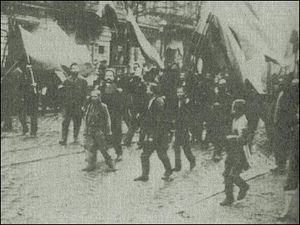
|
| Demonstrators carrying a portrait of the Tsar. |
A Petition, or an ultimatum?
The text of the petition was cited in Pazin's book. It is worth reviewing it in order to understand why the Tsar paid no attention to it and spoke plainly about a revolt. Only in textbooks on Russian history is it even now written that the workers wanted to bring to the Tsar "their needs and longings." Written in a rather ugly style of "lamentation," the petition begins with a description of the factory owners' disdain for the workers, the assertion that the laws only safeguard the workers' suppression, that Russia is perishing under the bureaucratic government", and so on. Further follows this passage, for example: “Is it possible to live under such laws? Wouldn’t it be better for all of us workers to die? Let the capitalists and bureaucrats live and enjoy themselves.” Further: “This is what has brought us to the walls of your palace. Here, we are seeking our final salvation. Do not refuse to help your people, lead them out of the grave of suppression… etc.” What do the “workers” see as the solution? In a Constituent Assembly, no more, no less, for, as it says in the petition, “It is necessary that the people help themselves and govern themselves.” The Tsar is given the suggestion to “Swiftly command that they call together representatives of the Russian land… Command that the elections in the Constituent Assembly would take place under conditions of total, secret, and equal votes. This is our main request; in it and upon it is built everything, this is the most important and only bandage for our wounds.” Then follow thirteen sections: all freedoms, the ministers’ responsibility “before the people,” political amnesty, discontinuation of all indirect taxes, and even “stopping the war at the people’s will.” The petition ended with the words, “Command it to be so, and swear that you will fulfill them… And if you do not will it, if you do not respond to our request, we will die here, on this square, before your palace.”
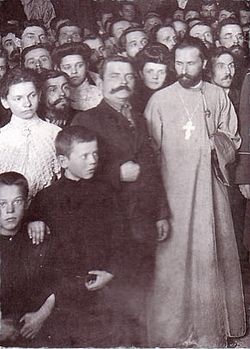 |
| Gregory Gapon and workers. |
There were different things going on.
Around 150,000 people took part in the demonstration. Columns marched from different ends of the city toward the center, were met by army battalions blocking the way, but the columns kept walking anyway. After the third warning, the battalions began firing, and only then did the people scatter. Some remember that there was no warning trumpet heard. But others recall that the column continued moving not only after the warning, but also after the first shots. This means that there were “animators” inciting them to further movement. Furthermore, someone from the columns shot at the battalions first. These were also not workers, but revolutionaries or students who had infiltrated the columns. Resistance to the army was particularly serious on Vasiliev Island. Here, barricades were set up. Bricks were thrown at the guard from a building under construction, and shots came from it as well.
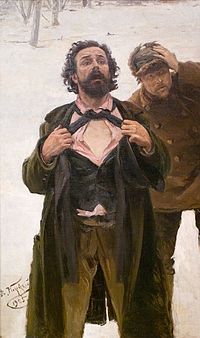
|
| Detail from the painting, "Vasiliev Island". K. Makovsky. |
According to official statistics, there were 128 people killed in all (including police), and 360 wounded (including guard and police). According to the Bolshevik historian V. Nevsky, who was a witness to the events of January 9, 1905, there were from 150 to 200 people killed. Meanwhile, certain authors (for example, Edward Radzinsky), and textbooks still write that there were thousands of victims.
The Tsar learned of it in the evening
Nicholas II wrote in his diary, “A heavy day! In Petersburg there were serious disorders as a result of the workers’ desire to reach the Winter Palace. The guard had to shoot in various areas of the city, and there were many killed and wounded. Lord, how painful and heavy!”
The Tsar found a person who restored order in the capital, although not immediately. This was D. F. Trepov, who became the Governor-General of the capital. On January 18, there was a meeting of ministers regarding the events, with Witte presiding. A manifesto was proposed in which sorrow and horror was expressed over the tragedy of January 9, and which would also point out that the Tsar did not know about the proposed march of the people to the palace, and that the army acted without his orders. However, the Tsar agreed with the opinion of Count Solsky, who said at the meeting that the army cannot act without the Tsar’s orders. The Emperor did not wish to throw off his responsibility, and refused the idea of a manifesto. He assigned Trepov the task of gathering a delegation of workers from various factories, which he received on January 19.
“You allowed yourselves to be drawn into error and deception by traitors and enemies of our Motherland,” said the Tsar. “I know that the life of a worker is not easy. Much should be improved and sorted out. But to announce your needs to me through a mutinous crowd is criminal.” At the Tsar’s initiative, a commission was established to clarify the workers’ needs with the participation of people chosen from amongst them. The elected representatives gathered and … presented a series of political demands! The commission thus never did begin its work.
Triumph of those seeking an occasion
In his book, On the Cusp of Two Epochs, Bishop Benjamin (Fedchenkov) wrote about January 9, “Here, faith in the Tsar was shot at (but not yet shot to death). I am a man of monarchistic bent, <…>, and I felt a wound in my heart <…> the charm of the Tsar fell. <…> Faith fell in both the Tsar’s power, and in that order [of society].” What, then, could be said of those who are not of monarchistic bent? The slogan, “Down with sovereignty!” was already in the air. Now, slander against the Tsar could and did reach its apogee. No one believed (and even now, many do not believe) that the Tsar was not in the capital on January 9. They wanted to assume, and do assume, that the Tsar himself did not want to receive a peaceful delegation of workers with a peaceful presentation of their needs and longings, but instead gave orders to fire upon the people. This false account of the event became so generally accepted, that it is still taught in the schools of various countries. At the time, a leftist satirical periodical called, L’Assiette au Beurre (literally, “plate of butter” or “profitable place”) published a caricature of Nicholas II, where the Tsar is holding his year old tsarevich (who was actually only five months old at the time) and showing him delightfully the palace square with a mass of dead people. A fierce looking Cossack stands behind him.
Osip Mandelstam wrote in one provincial newspaper for the seventeenth anniversary of the tragedy, that is, in 1922, an article entitled, “The Bloody Mystery of January 9”. There is a statement in this article that, “Any child’s cap, mitten, or woman’s scarf thrown pitifully that day in the Petersburg snow left a reminder that the Tsar must die, that the Tsar will die.” It is unlikely that the poet was recalling by this the executed royal children, or was gloating about revenge. He was writing about a “mystery of retribution.” [The death of both the protesters and the royal family remind us of "the mystery of iniquity, which is already at work." —OC]
No one cared about the meeting that the Tsar then had with the workers, about the large sum of money paid to the families that suffered on that day (50,000 rubles, the equivalent of just less than $600,000 today). Nor did anyone care about the government commission he formed to attend to the workers’ needs, nor that in 1906 the periodical Byloe (What Was) (No.1) printed an article with a truthful and thorough account of the events of January 9, 1905. Let’s hope that at least now there are people who want to know the truth about those events.
Translation by OrthoChristian.com

